Innovation and Creativity
Feb 26, 2024
By Ari Manor , CEO at ZOOZ

This is one in a series of articles that provide detailed and updated information about Innovation. In this specific article, which focuses on Innovation and Creativity, you can read about:
- Are Innovation and Creativity the Same
- Where Innovation and Creativity Meet
- Is Innovation the Same as Idea?
- How Innovation Differs from Creativity
- Innovation Versus Creativity
- Innovation without Creativity
- Innovation without Execution is Hallucination
For additional articles about Innovation, see the Topic Menu.
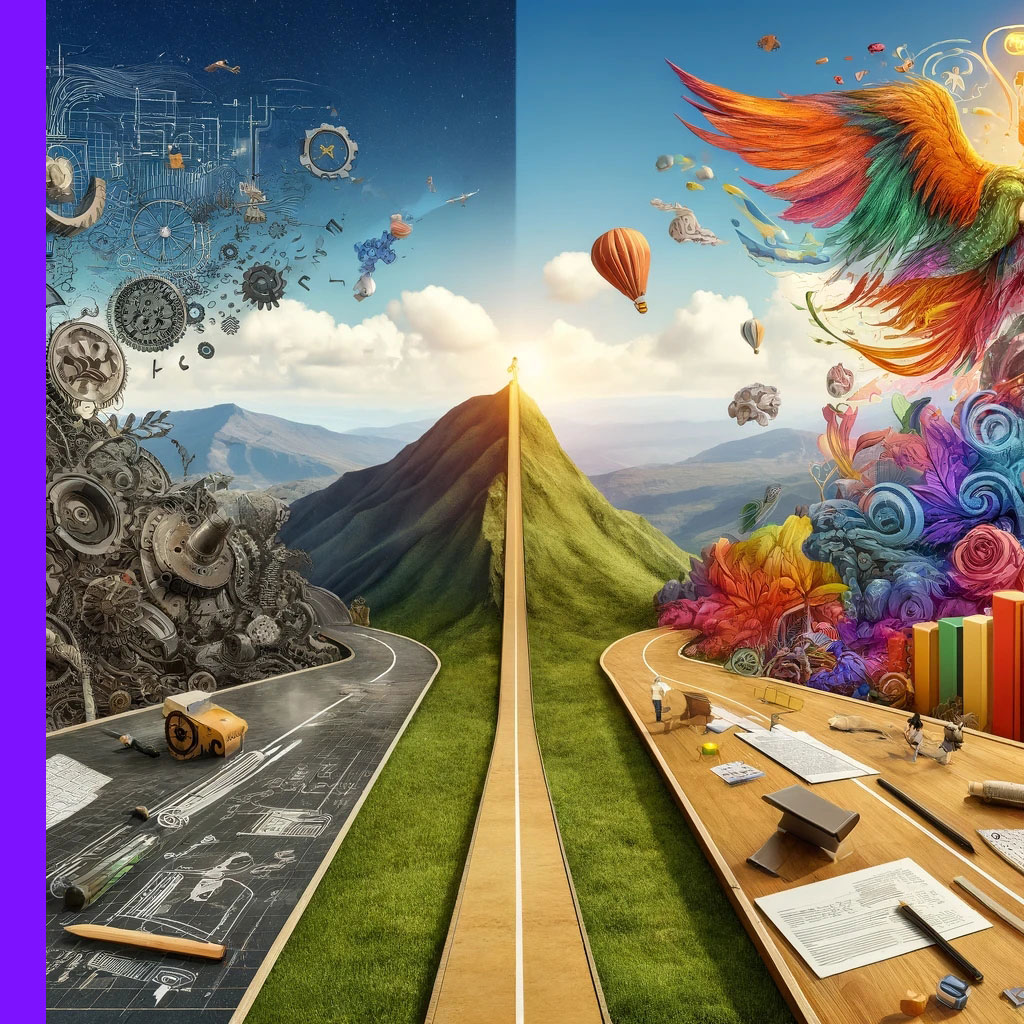
Are Innovation and Creativity the Same
Innovation and creativity are closely linked and sometimes used interchangeably, but nevertheless they are not the same:
- Creativity is about unleashing the potential of the mind to conceive new ideas. It’s characterized by the ability to perceive the world in new ways, find hidden patterns, make connections between seemingly unrelated phenomena, and generate solutions. Creativity involves thinking, then producing.
- Innovation, on the other hand, is the implementation of something new: a new idea, method, or device. It's the process of translating an idea or invention into a good or service that creates value for which customers will pay. To be called an innovation, an idea must be replicable at an economical cost and must satisfy a specific need. Innovation involves producing, then thinking.
Here's a simple list that distinguishes the two:
Creativity
- Ideation without the necessity of immediate application.
- Often subjective, can be art for art’s sake.
- About divergent thinking – generating many unique ideas.
Innovation
- The practical implementation of creative ideas.
- Objective in nature, with a focus on real-world application.
- Convergent thinking – narrowing down ideas to the best one.
For businesses, understanding the difference is crucial. Creativity is needed to fuel the fires of innovation, but without the structured approach of innovation, creative ideas might remain mere fantasies. Companies that cultivate both creativity and innovation are often the ones that revolutionize industries and push society forward.
So, are innovation and creativity the same? Certainly not. Creativity is the soil where the seeds of innovation are planted. But without the process of innovation, creative ideas may not see the light of day in the marketplace. Understanding this distinction can be the first step toward harnessing both effectively to drive growth and success in any endeavor.
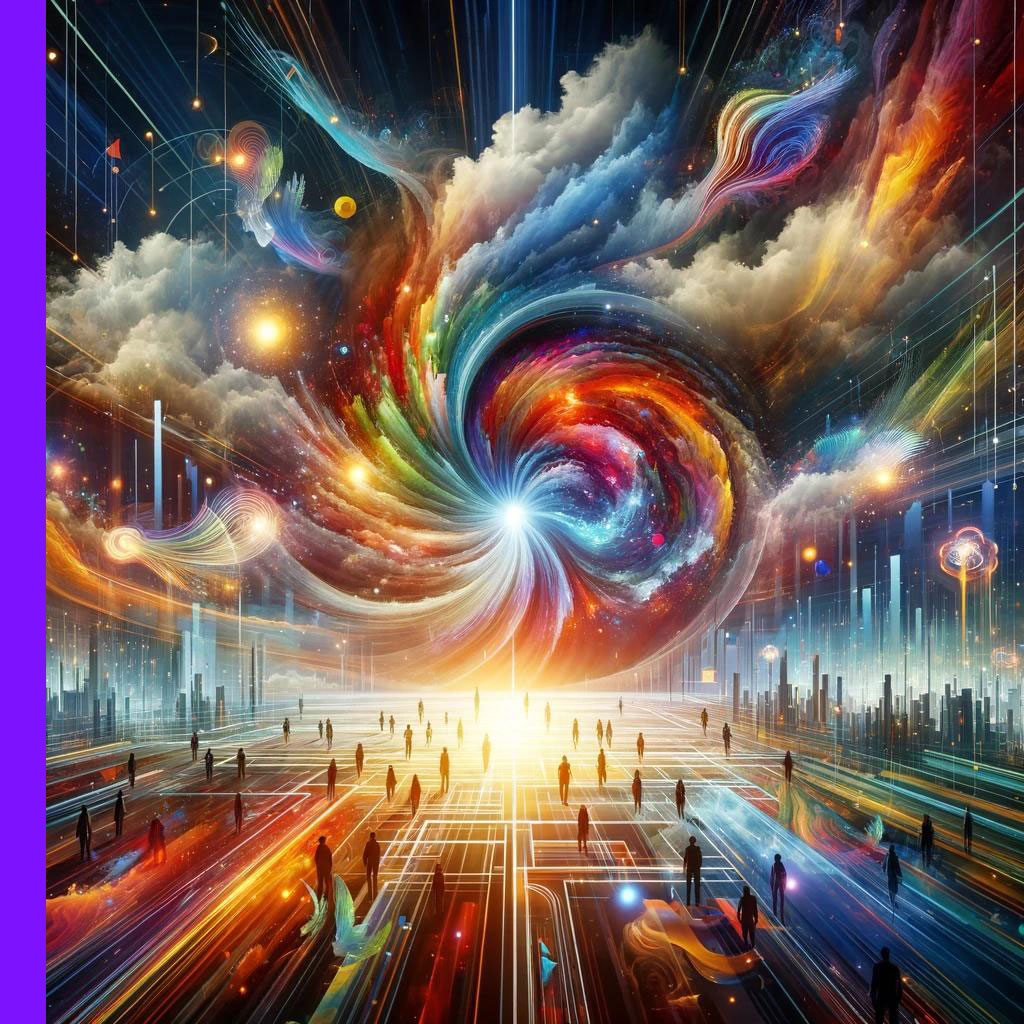
Where Innovation and Creativity Meet
Innovation and creativity intersect in the dynamic space where novel ideas are transformed into tangible improvements or creations that have real-world application and value. This convergence is the sweet spot for businesses and individuals looking to disrupt markets or establish new standards.
Innovation and Creativity Intersection
Here is how the intersection between Innovation and Creativity is navigated and why it’s essential for groundbreaking success:
- Fostering an Innovative Culture: Organizations that recognize the importance of creativity often establish environments where innovative thinking thrives. These are spaces where brainstorming is encouraged, and failure is seen as a step towards success.
- The Ideation Process: Creativity is the powerhouse of idea generation, and innovation is the framework that turns these ideas into reality. Whether it’s a new app, a business model, or a service, the ideation process is where innovation meets creativity.
- Design Thinking: This approach depends on creative problem-solving strategies that empathize with users and lead to innovative solutions. It involves five phases—empathize, define, ideate, prototype, and test—each requiring a balance of creative and innovative thinking.
- R&D Initiatives: Research and development (R&D) is the practical embodiment of this meeting point. R&D teams explore creative solutions to complex problems and then innovate to make these solutions viable.
- Cross-disciplinary Collaboration: When different fields come together—be it technology and design, or engineering and art—the fusion of diverse creative thoughts leads to innovations that might not occur within a single discipline.
Creativity and Innovation Meeting Point
In essence, creativity and innovation meet at the point of action. It's where a creative concept is pushed forward through the innovation process to become something that affects change and adds value. This meeting point is crucial for any organization because:
- It leads to the development of competitive advantages.
- It drives growth and adaptation in an ever-changing market.
- It encourages a forward-thinking mindset that is essential for long-term survival.
How to maintain a good flow between creativity to Innovation?
Maintaining a good flow between creativity and innovation in businesses involves fostering an environment where ideas can flourish and be effectively executed. Here are a few strategies to achieve this balance:
- Encourage Open Communication: Create an open environment where team members feel comfortable sharing their ideas and feedback. This can spark creativity and lead to innovative solutions.
- Foster Diversity and Inclusion: Diverse teams bring a wide range of perspectives, which can enhance creativity and drive innovation. Encourage collaboration between departments and individuals with different backgrounds.
- Implement Idea Management Systems: Use platforms or tools that allow employees to submit, share, and discuss ideas. This helps in tracking the progress of these ideas from inception to implementation.
- Provide Time and Resources for Experimentation: Allocate time and resources for employees to experiment with new ideas. This could be through hackathons, innovation labs, or dedicated "innovation time."
- Celebrate Failures and Successes: Recognize both successful innovations and constructive failures. This encourages a culture of risk-taking and continuous learning.
- Continuous Learning and Development: Offer opportunities for employees to learn new skills and stay updated on industry trends. This can inspire new ideas and improve the company's ability to innovate.
- Strategic Alignment: Ensure that creativity and innovation efforts are aligned with the business's strategic goals. This helps in prioritizing ideas that offer the most value.
- Leadership Support and Involvement: Leadership should actively support and participate in the innovation process. Their involvement can provide direction and resources needed to bring creative ideas to life.
Where innovation and creativity meet, there is potential for the extraordinary. It’s at this crossroads that the future is shaped and where visionaries and pragmatists alike find their common ground. Ensuring a seamless flow between creativity and innovation hinges on fostering an environment where these two forces meet and flourish, turning groundbreaking ideas into real-world value. At this critical junction, businesses can truly disrupt markets and set new standards by championing open communication, diversity, and the resources necessary for innovation to thrive.
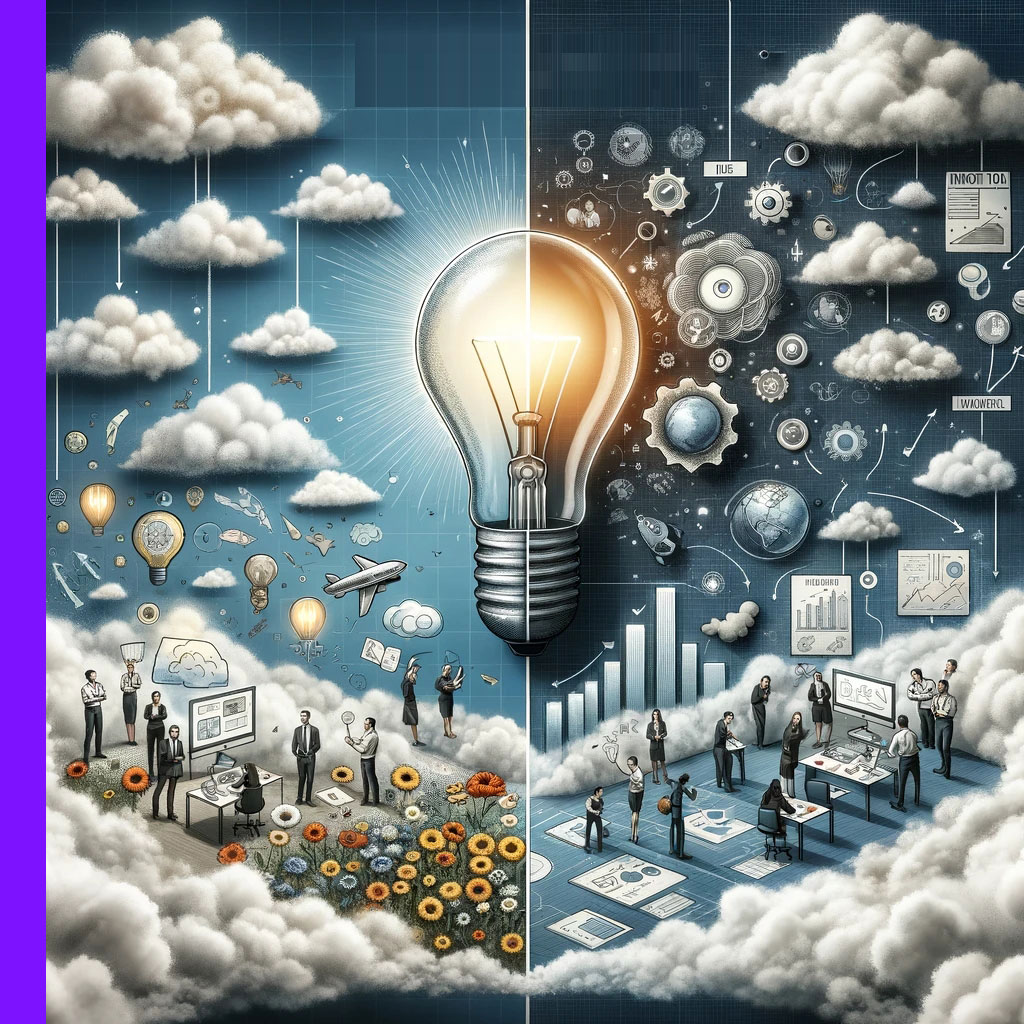
Is Innovation the Same as Idea?
The concepts of innovation and ideas, while interconnected, occupy distinct roles in the process of creating and implementing new products, services, or processes. Understanding their differences is crucial for effective strategy development and execution in any organization.
Ideas as Seeds: Ideas are the seeds from which innovations can grow. They represent the initial spark of imagination or thought that has the potential to solve a problem or address a need. Ideas are abundant and can range from incremental changes to radical breakthroughs.
Innovation as Realization: Innovation is the realization and implementation of an idea. It is the process of transforming an idea into a practical, viable product, service, or method that adds value. Unlike ideas, innovation involves execution, bringing the idea to life in a way that impacts the market or society.
Development Process: An idea requires nurturing, development, and validation before it can become an innovation. This process may involve research, prototyping, testing, and refinement based on feedback and performance.
Market Orientation: Ideas, in their raw form, do not need to demonstrate market viability. However, for an idea to become an innovation, it must prove its worth in the market—meeting customer needs, solving specific problems, or providing new opportunities for growth.
Example
- Having an idea for a new type of energy-efficient light bulb is just the beginning.
- The innovation occurs when that idea is developed, produced, and successfully marketed, changing the way people illuminate their homes and reducing energy consumption.
Challenges and Risks
Not all ideas lead to innovation. The journey from concept to market can be burdened with challenges, including technical feasibility, funding, market acceptance, and competition. Innovation requires overcoming these obstacles.
In conclusion, while an idea is a necessary starting point, it is not synonymous with innovation. Innovation is the process through which ideas are actualized, made tangible, and brought to market, creating real-world impact. Understanding this distinction helps organizations prioritize their efforts and resources towards ideas with the greatest potential for successful innovation.
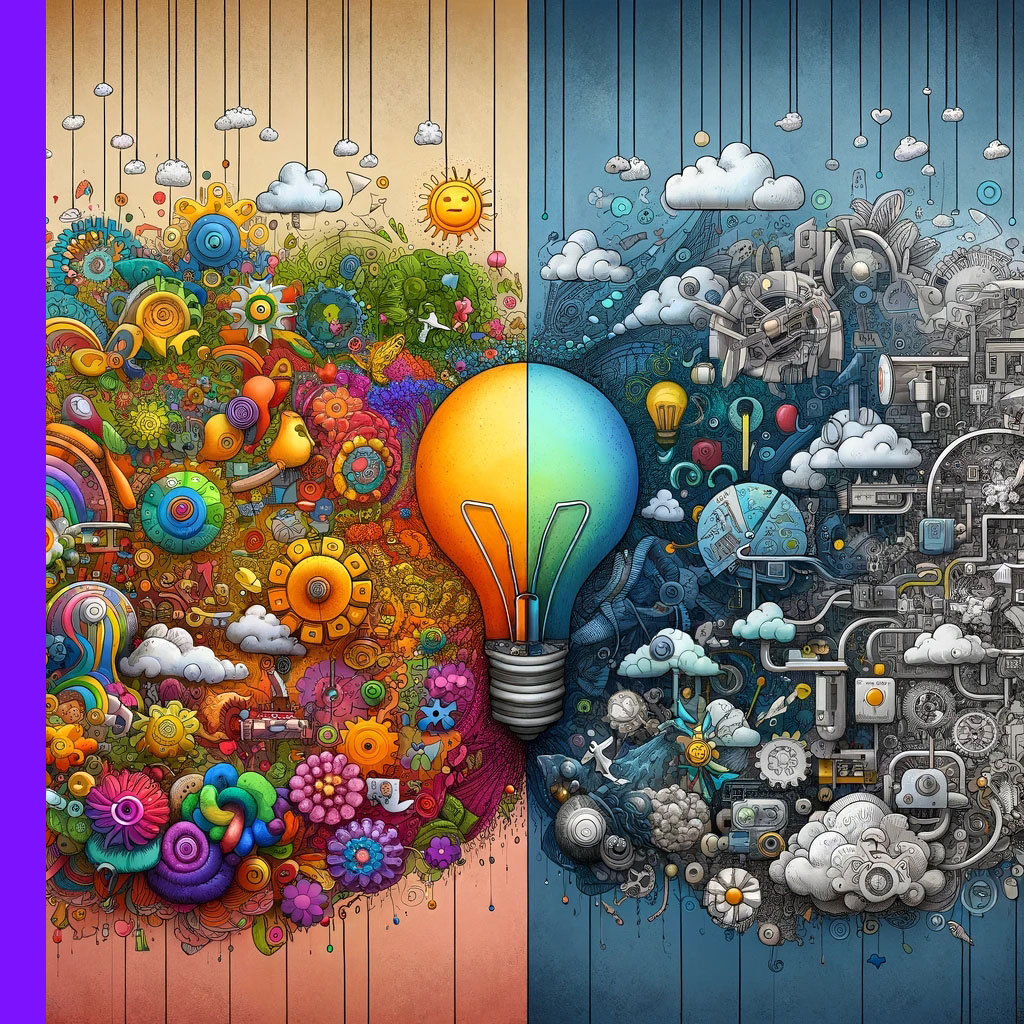
How Innovation Differs from Creativity
While creativity and innovation often walk hand in hand, understanding how they differ is crucial for anyone looking to harness their power in the business world or any other field. Here are the key distinctions:
Definition and Scope
- Creativity is inherently about generating new and original ideas. It's an abstract process that involves dreaming up new concepts, initially without the constraints of practicality or applicability.
- Innovation is the application of those creative ideas in a practical way. It’s about implementation and bringing something new to the market or society — a product, a solution, a method, or even a new way of thinking.
Process Orientation
- Creativity is often non-linear and chaotic. It doesn’t follow a predictable pattern and it may thrive in open, unrestricted environments. However, it can be accelerated using thinking tools (constrains increase creativity).
- Innovation is more structured. It involves specific stages such as ideation, validation, prototyping, and commercialization. It’s a path with clear milestones and objectives.
Outcome
- Creative endeavors don't necessarily result in tangible outcomes. The arts, for example, are a product of creativity that may not have a direct functional purpose other than to evoke emotion or provoke thought.
- Innovations lead to definable change. They result in something that can be implemented and often measured — a new device, an improved service, or an enhanced process.
Risk and Failure
- Creativity involves taking risks and embracing failure as a part of the journey. It's about pushing boundaries and exploring the unknown.
- Innovation also involves risk, but it's a calculated one. Innovations are typically pursued in the context of solving a specific problem or addressing a particular need, often with a business case or clear goal in mind.
Value Creation
- Creativity in itself does not necessarily create value. A creative idea might be brilliant, but if it’s not applicable or needed, it might not hold value in a business or practical sense.
- Innovation is driven by the goal of creating value. It turns creative ideas into something useful and desirable, which people are willing to pay for.
In summary, creativity is about unleashing potential and exploring possibilities without the constraints of the real world, while innovation is about grounding these possibilities within the realm of what is feasible and valuable. Businesses that foster both are often the ones that lead their industries, as they can dream big and then make those dreams a reality.
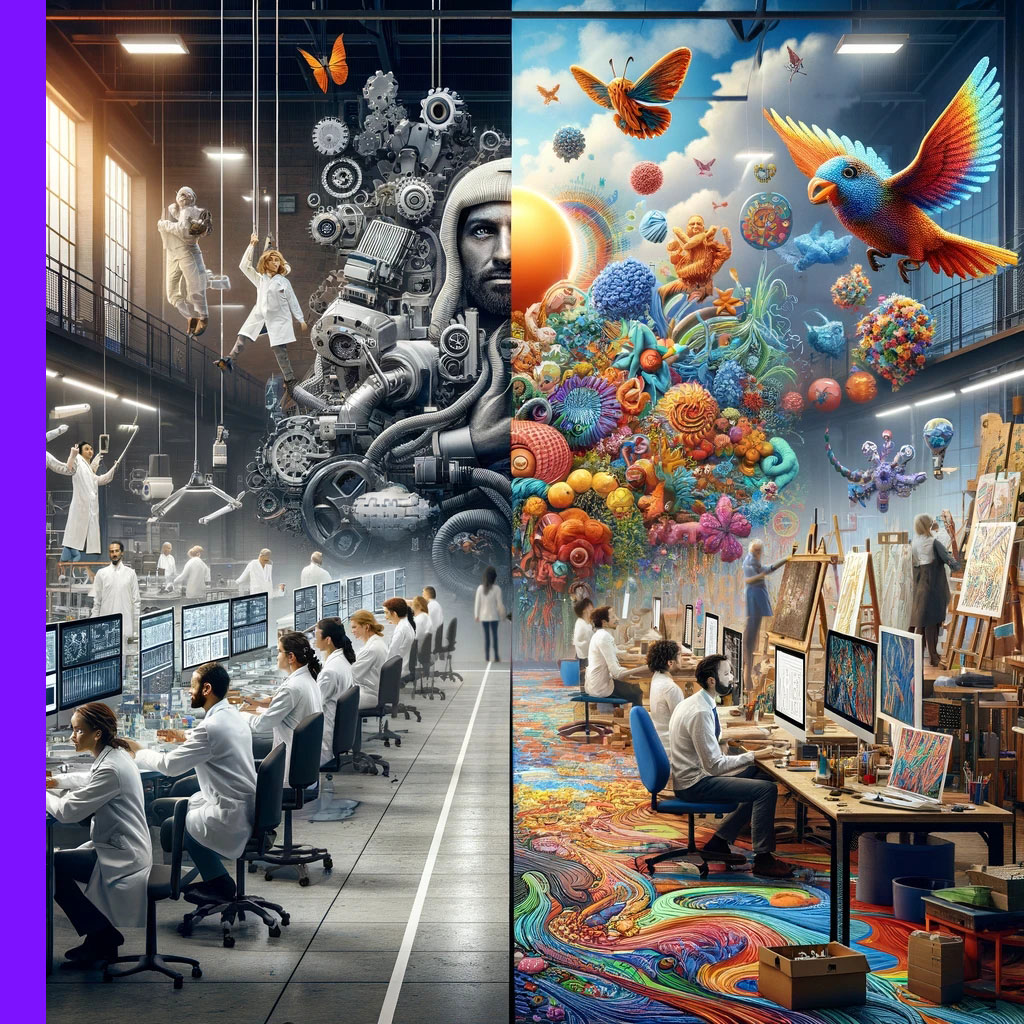
Innovation Versus Creativity
The debate on innovation versus creativity is a longstanding one, with each playing a critical role in successful outcomes in business and other fields. Following, we delve into their relationship and differences.
Origin and Dependence
- Creativity is the origin of new ideas. It’s the mental capacity to conceive something original or unusual. It relies on innovation processes to take shape and manifest in reality.
- Innovation is the application and successful exploitation of new ideas. It depends on creativity but extends beyond it to include the delivery of real-world value.
Nature of Output
- Creative outputs are often intangible, such as ideas, concepts, artistic expressions, or theories.
- Innovations result in tangible outcomes like new products, services, or improved processes that have a practical impact.
Measurement
- Creativity is inherently subjective, making it challenging to quantify. What may appear as a novel and creative idea to one individual might not seem so to another. Consequently, it is common to engage panels of subject matter experts to assess the creativity level of specific ideas, often employing a subjective scale, such as 1 to 7, to harness “expert-crowd” wisdom in measuring creativity.
- Innovation can be measured in terms of market success, efficiency gains, increased revenue, or other quantifiable metrics. Businesses frequently assess innovation through metrics like the percentage of revenue from new products or the number of new products introduced each quarter.
Utility
- Creativity does not always have immediate utility or application. A creative idea might be appreciated for its novelty alone.
- Innovation inherently aims at utility. It’s not just about creating something new; it’s about creating something new that solves a problem or fulfills a need.
Risk Factor
- Creativity involves the risk of the unknown. It requires venturing into unexplored territory without any guarantee of success or acceptance.
- Innovation involves calculated risks. Although innovative projects can fail, they are typically pursued after some level of validation or proof of concept.
Cultural Influence
- Creativity can be influenced by cultural, social, and personal factors. It can be seen as an expression of individual or collective consciousness.
- Innovation often emerges from a culture that not only values creativity but also supports risk-taking, experimentation, and the practical realization of ideas.
In essence, while creativity is necessary for innovation, it is not sufficient on its own. Creativity is about coming up with the big idea; innovation is about executing the idea, making it a reality. They are two sides of the same coin; without creativity, there can be no innovation, and without innovation, creative ideas remain dormant and unrealized. Understanding their interplay is essential for anyone looking to drive progress, whether in business, technology, or the arts.
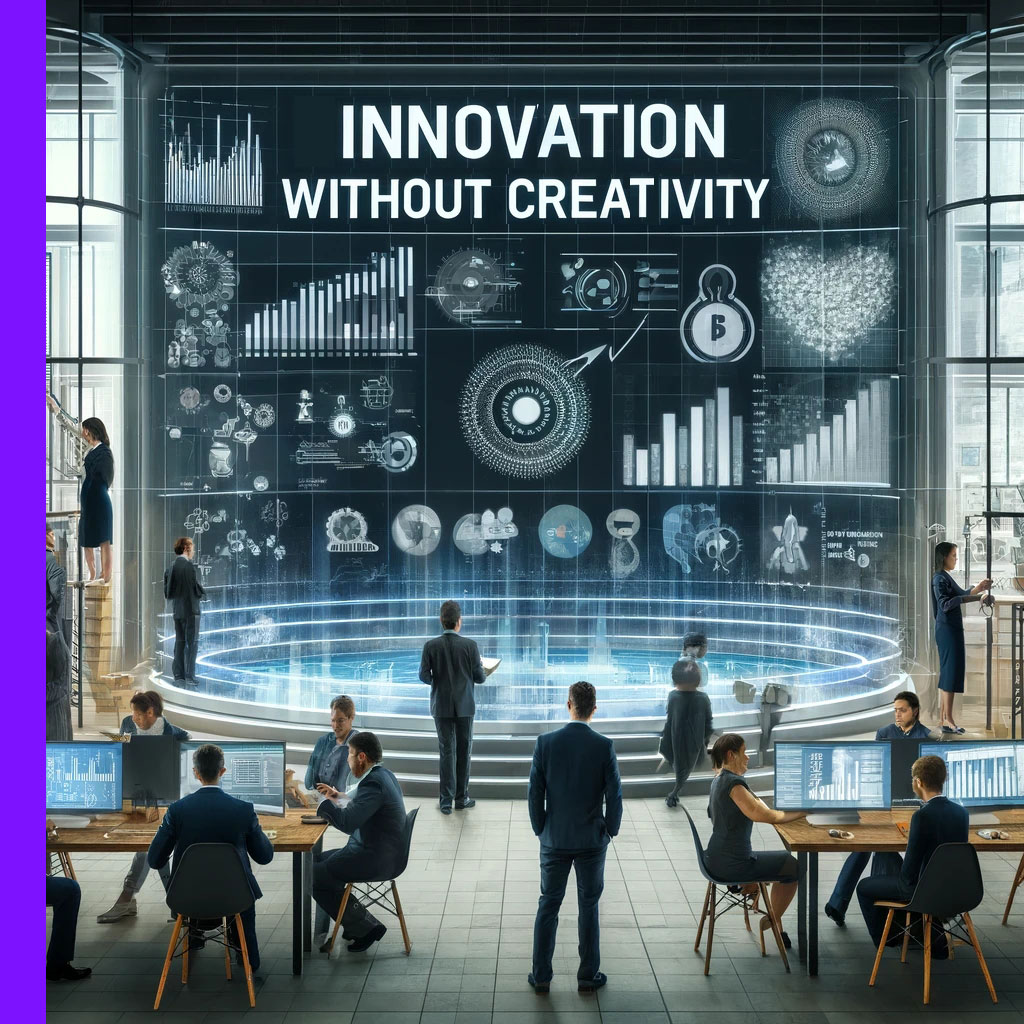
Innovation without Creativity
The notion of innovation without creativity may seem counterintuitive; after all, how can something be novel or improved without a creative spark? However, innovation does not always require creativity in its purest form. Let’s explore how innovation can manifest without traditional creativity:
- Incremental Improvements: Innovation often occurs as incremental changes to existing products or processes. These are not necessarily born from a creative idea but from systematic analysis and improvement over time.
- Toyota's philosophy of Kaizen, which focuses on continuous, incremental improvements in manufacturing processes, exemplifies innovation without the need for groundbreaking creativity, leading to significant enhancements in efficiency and quality over time.
- Toyota's philosophy of Kaizen, which focuses on continuous, incremental improvements in manufacturing processes, exemplifies innovation without the need for groundbreaking creativity, leading to significant enhancements in efficiency and quality over time.
- User Feedback and Data-Driven Decisions: Many innovations come from listening to user feedback or analyzing data trends rather than creative brainstorming. For instance, a feature added to a software product based on user request is an innovation derived from a practical need, not necessarily a creative process.
- Spotify’s use of data analytics to refine its music recommendation algorithms is a prime example of innovation driven by user feedback and data trends, optimizing user experience without traditional creative ideation.
- Spotify’s use of data analytics to refine its music recommendation algorithms is a prime example of innovation driven by user feedback and data trends, optimizing user experience without traditional creative ideation.
- Combining Existing Concepts: Sometimes, innovation results from the combination of existing ideas or technologies. The creativity involved is minimal since it relies on pre-existing elements being brought together in new ways, often driven by practical problem-solving rather than creative thought.
- The creation of the smartphone was an innovation that combined existing technologies—telephone, internet, camera—into a single device, transforming communication without originating from a singularly creative idea.
- The creation of the smartphone was an innovation that combined existing technologies—telephone, internet, camera—into a single device, transforming communication without originating from a singularly creative idea.
- Technology-Enabled Innovations: With the advent of AI and machine learning, many innovations are now data-driven. For example, algorithms can identify patterns leading to new marketing strategies or financial models without human creative input.
- Netflix's recommendation system, powered by machine learning, exemplifies innovation where algorithms analyze viewing patterns to suggest personalized content, showcasing how technology can drive innovation independently of human creativity.
- Netflix's recommendation system, powered by machine learning, exemplifies innovation where algorithms analyze viewing patterns to suggest personalized content, showcasing how technology can drive innovation independently of human creativity.
- Regulatory Changes: At times, changes in regulations or compliance standards necessitate innovation. Companies may have to alter their processes or products to comply with new laws. While this requires ingenuity, it is not necessarily rooted in creativity but in necessity.
- The financial industry's development of secure, blockchain-based transactions in response to increasing demands for transparency and security demonstrates innovation driven by the need to comply with regulatory standards, rather than creativity.
- The financial industry's development of secure, blockchain-based transactions in response to increasing demands for transparency and security demonstrates innovation driven by the need to comply with regulatory standards, rather than creativity.
- Adaptation to Market Changes: Businesses often have to innovate to survive due to changes in market conditions or consumer behaviors. This type of innovation is reactive and adaptive, rather than being driven by original creative ideas.
- The pivot of many restaurants to offering contactless delivery and pickup services during the COVID-19 pandemic illustrates innovation born out of necessity to adapt to changing market conditions, rather than from a creative breakthrough.
- The pivot of many restaurants to offering contactless delivery and pickup services during the COVID-19 pandemic illustrates innovation born out of necessity to adapt to changing market conditions, rather than from a creative breakthrough.
- Inventive Thinking Tools: Originally designed for engineers addressing complex technological challenges, Systematic Inventive Thinking (SIT) offers a structured, step-by-step approach to uncovering feasible and unexpectedly original solutions. When applied to product development and creative advertising, these tools maintain a methodical and systematic nature, eliminating the need for spontaneous creativity. While individual steps may not appear creative in isolation, the final outcomes—be it solutions, inventions, or advertisements—are remarkably and surprisingly innovative.
- At Kapro, a precision , a precision tools company, participants in our Systematic Innovation™ workshops utilized SIT tools to systematically develop idea banks with hundreds of innovative ideas for new rulers, rafter squares, metric tape measures, levels, and laser levels. The process did not rely on waiting for serendipitous moments, as SIT provides a framework and six inventive thinking tools for generating ideas in a structured, step-by-step manner. Further details can be found here, along with some successful innovations we developed, which are presented here.
- At Kapro, a precision , a precision tools company, participants in our Systematic Innovation™ workshops utilized SIT tools to systematically develop idea banks with hundreds of innovative ideas for new rulers, rafter squares, metric tape measures, levels, and laser levels. The process did not rely on waiting for serendipitous moments, as SIT provides a framework and six inventive thinking tools for generating ideas in a structured, step-by-step manner. Further details can be found here, along with some successful innovations we developed, which are presented here.
In summary, while creativity is a source of innovation, it is not the only one. Innovation can also arise from necessity, customer insight, market trends, the strategic combination of existing ideas, and structured thinking tools. These innovations may lack the flamboyance of creativity-driven breakthroughs, but they are no less significant in their impact on business success and progress. Understanding this broader scope of innovation can help organizations systematically innovate time and again, without waiting for serendipitous moments.
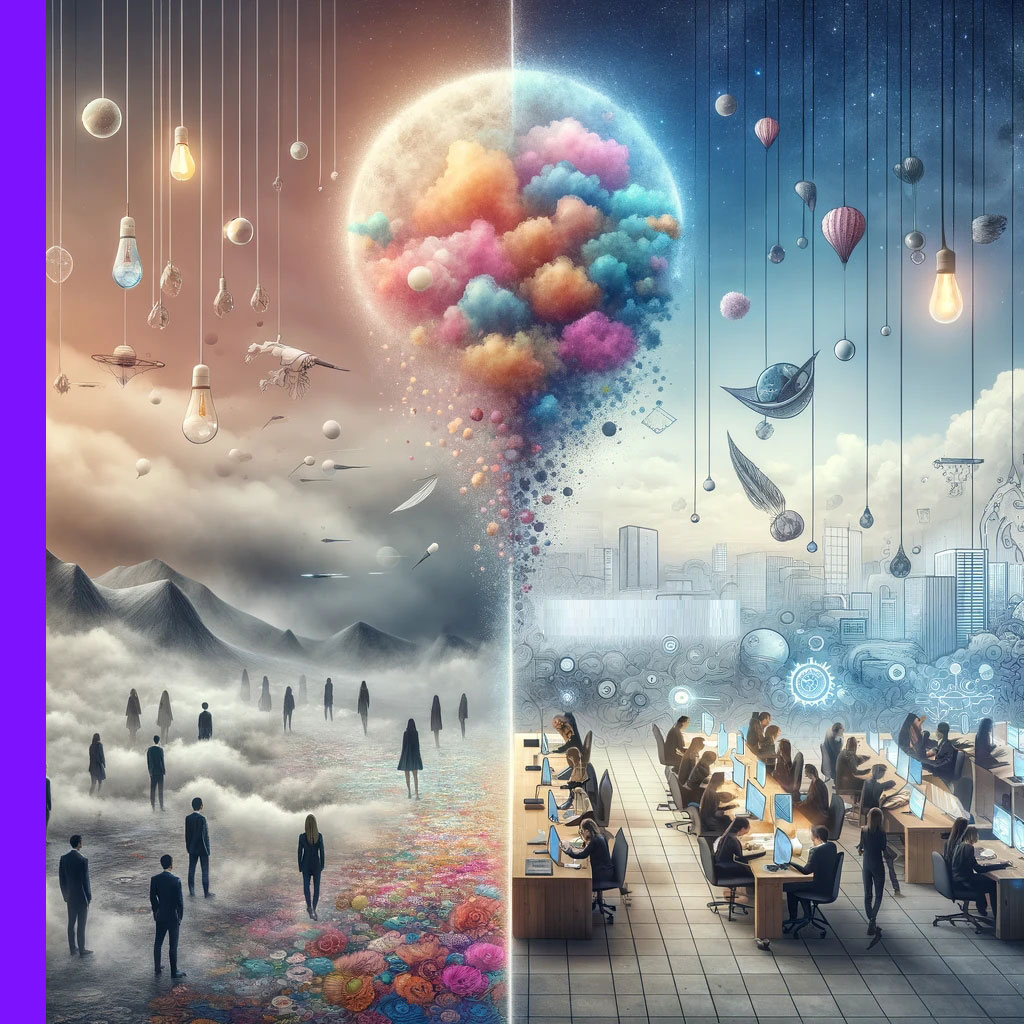
Innovation without Execution is Hallucination
The saying "Innovation without execution is hallucination" encapsulates a profound truth in the business and creative worlds. Having groundbreaking ideas is only part of the journey; the real challenge lies in bringing these ideas to fruition.
Here's why execution is indispensable for innovation:
- Ideas are Plentiful: The world is not short of ideas. Many individuals and companies alike can dream up revolutionary products or services. However, the transition from concept to reality is where many falter. Without execution, ideas remain abstract and untested.
- Execution Brings Validation: Execution transforms ideas from hypotheses into tangible products or services. It's through this process that an idea is validated against the realities of the market, technical feasibility, and consumer preferences.
- Risk and Reward: Execution involves risk. It requires investment, resources, and often, a leap of faith. However, it's also the stage where value is created. An idea, no matter how innovative, cannot generate value unless it's executed and brought to the market.
- Learning Through Doing: Execution is a learning process. It often involves trial and error, adaptation, and problem-solving. Through execution, teams gain insights that can lead to refinements, pivots, or even entirely new ideas that are more aligned with market needs.
- Competitive Advantage: Speed and efficiency in execution can be a significant competitive advantage. In fast-moving sectors, being the first to market with an innovative solution can define a company's success.
- Sustainability: For innovation to contribute to long-term sustainability and growth, it must be executed in a way that meets not only the current but also future market demands and challenges. Execution bridges the gap between short-term success and long-term vision.
Example:
- Consider the tech industry, where many companies have had similar ideas for products or services.
- Often, the winners in this space are those that can execute their ideas most effectively, not necessarily those who had the idea first. This is well demonstrated by the following case study:
 Case Study: Execution at Facebook
Case Study: Execution at FacebookIn the realm of social networking, Facebook's rise to dominance is a testament to the power of execution. While not the first to conceive the idea of a social network, Facebook's journey illustrates how meticulous execution can outpace initial innovation:
- Company: FaceBook, Mentlo Park, California, USA (Founded in 2004)
- Early Landscape: Before Facebook, platforms like MySpace and Friendster were already exploring the concept of online social networks. However, these platforms struggled with issues like user interface complexity and scalability.
- Facebook's Entry: When Mark Zuckerberg launched Facebook in 2004, it was initially just another social networking site among many. However, Facebook differentiated itself not through a novel concept but through superior execution in key areas:
- User Experience: Facebook introduced a cleaner, more intuitive interface that appealed to a broad audience, focusing on ease of use and minimalistic design.
- Scalability and Performance: Early on, Facebook invested in robust backend infrastructure, ensuring that the platform could grow without significant performance hitches, a challenge its predecessors faced.
- Iterative Improvements: Facebook's approach to continuous improvement and feature development, such as the introduction of the News Feed, kept the platform evolving and users engaged.
o Global Expansion: While initially limited to Harvard students, Facebook's strategic expansion to other universities, then high schools, and eventually to the general public, was executed with precision, fueling its rapid growth.
- Monetization Strategy: Facebook's development of an advertising model that leveraged its vast amounts of user data was executed in a way that drove significant revenue while keeping the platform free for users.
The culmination of all these efforts is a platform that not only outlived its early competitors but also became an integral part of daily life for billions of people worldwide. Facebook's success underscores that in the tech industry, while many may arrive at a similar idea, the victor is often the one who executes that idea most effectively. Through relentless focus on execution, Facebook turned a common concept into a global phenomenon, demonstrating that execution truly is everything.
- Company: FaceBook, Mentlo Park, California, USA (Founded in 2004)
In summary, while creativity and idea generation are crucial components of innovation, execution is what turns potential into reality. Without the ability to execute, even the most innovative ideas are doomed to remain as mere fantasies. Therefore, companies and individuals must focus not just on ideation but also on developing the capabilities, processes, and culture that support effective execution.
Systematic innovation
Interested in getting help with systematic innovation processes and developing new products and services?
Contact us: info@zooz.co.il ,+972-9-958-5085
Innovation Articles
- Innovation overview
- Innovation management
- Innovation methods
- Innovation tools
- Innovation and creativity
- Innovation and other disciplines
- Innovation in organizations
- Innovation career
- Innovation importance
- Innovation goals
- Innovation values
- Inspiration for innovation
- Innovation education
- Product innovation
- Service innovation
- Technological innovation
- Innovation examples
- Innovations across various industries
- Innovation glossary (200 terms)





